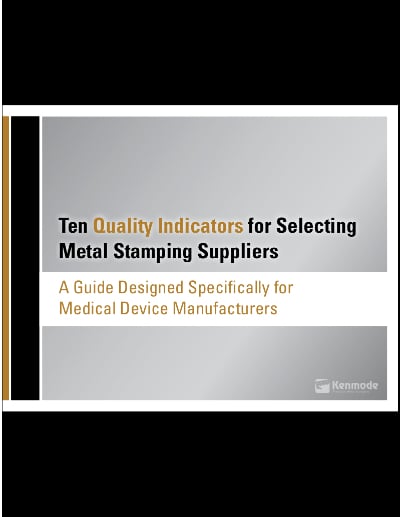Highly specialized and regulated industries, such as the medical device industry, demand adherence to their own preferred standards for manufacturing quality. These industry-specific standards require that metal stamping companies keep current on a global scale.
Worldwide, some 1.5 million medical devices are currently on the market and thousands more are introduced every year, according to the International Organization for Standardization. How do the users of medical devices - or the public in general - know that these devices will function properly? That's where ISO certifications come in. ISO certification 13485:2003 is the standard specific to quality management in the medical industry, which defines critical areas that impact the design, process, quality, and manufacturing reliability for medical devices.
Which quality methods matter most to medical device manufacturers?
Although the general validation and verification methods that many metal stamping companies use can apply to all sorts of industries, medical device manufacturers favor the alphabet soup known as DQ/IQ/OQ/PQ, which relates to verification and validation of both design activities and process development.
The preferred DQ/IQ/OQ/PQ method is spelled out in Section 7 of the ISO 13485 standard. This dictates very specific requirements for Product Realization, in particular the validation and verification requirements necessary in the design phases (section 7.3) of the launch process as well as the manufacturing process development (section 7.5).
The validation process consists of identifying and testing all aspects of a process that could affect the final test or product. Prior to the testing of a process, the system must be properly qualified. Qualification includes the following steps:
Design Qualification (DQ)
DQ defines the functional and operational specification of the instrument, program, or equipment and details the rationale for choosing the supplier.
Installation Qualification (IQ)
IQ demonstrates that the process or equipment meets all specifications, is installed correctly, and all required components and documentation needed for continued operation are installed and in place.
Operational Qualification (OQ)
OQ demonstrates that all facets of the process or equipment are operating correctly and will produce acceptable results as well as establishes limits (worst case) of the process parameters.
Performance Qualification (PQ)
PQ demonstrates that the process or equipment performs as intended in a consistent matter over time.
For metal stampers, OQ and PQ top the list.
In the quality planning process, medical device manufacturers should look for metal stamping companies that speak their quality language and put it into practice. Specifically, quality-minded metal stampers will conduct initial capabilities studies, define control plans, ensure that correct tooling parameters are established from the outset, and confirm consistency in production runs on a continual basis.
Since the malfunction of a medical device, particularly for implantable devices, can be a matter of life and death, quality control through OQ and PQ is absolutely critical for even the smallest component.
Interested in learning more about metal stamping quality controls for medical components? These blog articles are a great read ...
5 Tips to Smooth Transition from Medical Device Design to Manufacture
Starting DFM Early with Metal Stamping Companies Limits Part Failure Risk
Want consistent precision metal stamping quality? Insist on SPC.


